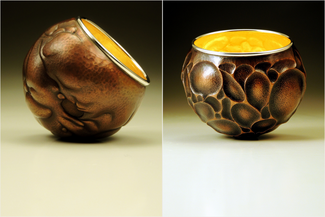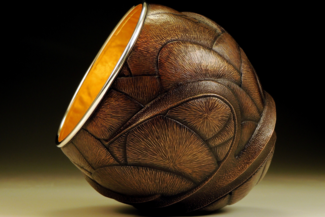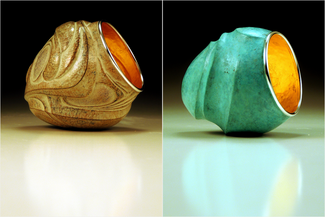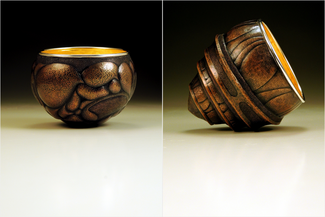Raising and Chasing a Vessel Form
This will be a two-part workshop. During the initial days we will focus on traditional techniques of angle raising to create vessel forms. Utilizing 6-inch copper disks as the initial starting point, we will explore how to form both single- and multi-node vessels by hammering over various forming stakes.
Typically the middle day of the workshop becomes the crossover day where we utilize one of the vessels raised as a form to further embellish with designs and textures. These embellishments are created using the technique known as chasing, including a variation I've been calling hammer chasing. In place of traditional pitch we will be using a microcrystalline wax, one commonly used in bronze casting. During the course of the workshop, we will also cover the basics of making ones own chasing tools, and participants will have the opportunity to make some if they wish. We will also cover how to make and solder on a wire rim to finish the edge of a vessel.
This workshop will be technique and information oriented rather than project oriented, meaning very few participants will actually finish a piece during the time we have. However, everyone should get lots of information about the processes. Considerable time will be spent practicing the techniques while working on our pieces, but due to the labor intensive nature of both the raising and chasing techniques you shouldn’t expect to complete a piece in class.
This workshop is intended for all skill levels.
Meet the instructor
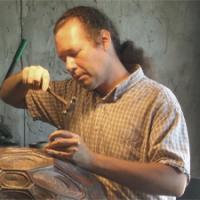
David Huang was born, raised, trained, and is currently living in the Western Michigan region. He began his metalsmithing education at East Kentwood High School and continued on to earn his BFA with an emphasis in metalsmithing from Grand Valley State University. Working full-time as a self-employed artist since 2003, David is represented by galleries around the US. His work has been featured in Metalsmith Magazine, American Craft, and numerous other books and publications. He has also traveled throughout the US teaching workshops focusing on both raising and chasing.
Materials & Tools
There is a $50 materials fee for this class that is payable upon registration. The materials kit includes all of the metal and other consumables you will need for class.
Recommendations - these items are not required. Students often inquire about which tools the instructor recommends. Below is a short list of David's recommendations.
Raising hammer.
- Peddinghaus raising hammer (RioGrande 14 oz. head weight)
- Huang Raising Hammer (Saign Charlestein) - These are premium hammers for those who love tools or know they will be doing a lot of raising and can invest the money. There are three sizes, if you are just getting one David recommends the middle 375g size. It is the most versatile one that will work well for most jobs.
Chasing hammer.
- Chasing hammer (RioGrande 4 oz.)
- Forged cross peen chasing hammer (Saign Charlstein) - For those who know they are really into chasing and want to invest significantly more money into a premium chasing hammer.
- Closed-toe shoes - required in the Metalwerx studio
- Gloves - In particular a glove for the hand that will be holding the vessel while hammering. Some type of heavy leather work glove is recommended. Insulated leather work gloves can be even nicer in that they offer a bit more padding. However, it is hotter to wear these. No need to get anything super nice or expensive as they will get trashed over time if you continue raising
- Safety glasses - if you prefer your own, otherwise there will be plenty in the studio
- Hearing protection - as above
Optional/Not required:
- If students happen to have something like a Fretz # 9 hammer already, they might want to bring that along. The instructor will be showing his "hammer chasing" technique that uses small hammers such as the Fretz # 9. The instructor will have a few such hammers with him that students can use.
- Round wire - 1 foot (per vessel) of 8, 10, or 12 gauge wire works well, visually, with a vessel raised from a 6"disk. Fine silver, copper, brass, or bronze can be used according to preference. This is for making wire rims that would be soldered on the raised vessel. If you don’t want to do this then don’t worry about having the wire. Very few students even get their vessel to this stage during the time we have in class.
- Medium silver wire solder - 1 foot (per vessel). If you don’t already have medium silver wire solder there is no need to make a special order, the instructor will have extra to sell on an as needed basis at cost.
- Files and abrasive paper - Various files and a range of grits of abrasive paper would be good for making a chasing tool or two, along with cleaning up excess solder after soldering on a rim if students get that far. The instructor will talk more about what he uses to finish rims at the workshop. Keep in mind that not too many people get to the rim polishing stage during a workshop, and the instructor will have finishing items for students to use.
- A pencil - For drawing your initial design on the vessel. The instructor recommends a mechanical pencil with .5mm lead, but any pencil should do fine.


